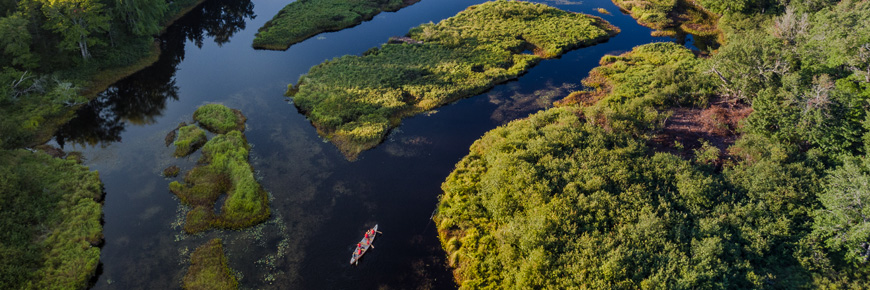
Freshwater ecosystem conservation
Kejimkujik National Park and National Historic Site
Kejimkujik: Home to a healthy freshwater ecosystem
Whether it’s swimming, canoeing, or fishing, every year thousands of visitors enjoy the natural beauty of Kejimkujik’s many lakes and rivers. But these bodies of freshwater are also used by hundreds of different species, each with an important role to play in the ecosystem. The freshwater in Kejimkujik is vital to the survival of several species at risk, including Blanding’s turtle, Snapping turtle, Eastern ribbonsnake, and American eel.
Kejimkujik's freshwater ecosystem is no stranger to environmental threats, including the enduring effects of acid rain, and most recently, invasive fish species.
The threat: invasive fish species, including Chain pickerel
Parks Canada has an important role to play in helping to mitigate the impacts of invasive species by protecting and restoring healthy, resilient ecosystems and contributing to the recovery of species at risk.
In 2018, Parks Canada confirmed the presence of the invasive Chain pickerel in the park’s aquatic ecosystems. Chain pickerel are a predatory fish in the Pike family whose native range is the Eastern United States from Florida to south-west Maine, east of the Appalachians. Chain pickerel were introduced into Nova Scotia illegally in 1945 and have since spread via range expansion and illegal introductions throughout most of the province.
Chain pickerel can have significant negative effects on freshwater ecosystems. Chain pickerel are voracious elite ambush predators and prey on almost anything in the water. In addition to preying directly on Brook trout and other native species, Chain pickerel also out-compete them for food resources.
Parks Canada is taking action to try and mitigate these effects where possible, study the effects, and make the best decisions possible about the management of important watersheds within Kejimkujik. In collaboration with Mi’kmaq and other partners, Parks Canada has been working to identify the best available long-term solutions to help protect the park from invasive fish.
What is Parks Canada doing about it?
Preventing introduction
The introduction of invasive fish is a landscape-level problem that is not unique to Kejimkujik and we are working with partners to raise awareness and explore management options.
Permanently protecting the entire park or the Mersey River system within the park from invasive fish is not possible, due to factors including the size of the river, the multiple access points, and the location of the headwater. Furthermore, the system is already compromised by Smallmouth bass upstream of the park.
Parks Canada conducted a risk assessment and determined which areas of the park could be successfully protected long term. In 2018, upon learning of the presence of Chain pickerel in the park, Kejimkujik staff installed a temporary fish barrier inside the park to prevent invasive fish from entering a specific area of the park. In 2019, Parks Canada successfully installed two barriers on Cobrielle Brook which are preventing invasive fish passage upstream into ecologically-unique Cobrielle and Mountain lakes. We continue to assess Chain pickerel and native fish movement at these sites.

Removing invasive fish and protecting native fish
In consultation with local stakeholders, and partners, Parks Canada implemented new fishing regulations to protect the native fish species in the park, including zoning the entire park for mandatory release of native fish species and mandatory retention of invasive fish.
Since 2014 Parks Canada has worked with Nova Scotia Department of Inland Fisheries and Aquaculture on controlling a population of Smallmouth bass, illegally introduced into Cannon Lake, just outside the park boundary. That removal work has been extremely successful with the Cannon Lake population reduced almost tenfold since 2014. The success we’ve had with Smallmouth bass gives us hope we can affect positive changes and mitigate some of the negative impacts of Chain pickerel within areas of Kejimkujik.
Chain pickerel removal effort in 2019 focussed on Loon Lake and Grafton Lake, with 115 Chain pickerel removed by park staff and volunteers. With a significantly shortened field season and volunteer capacity in 2020, removal effort was less sustained. Through the course of monitoring work, staff and researchers did, however, continue to remove pickerel from Kejimkujik waterways.
Moving forward, Parks Canada’s invasive fish detection and removal efforts will be amplified by the use of an electrofishing boat. Electrofishing is a non-lethal method of quickly assessing a lake for the presence of invasive fish, monitoring native fish species and removing unwanted species from target locations. Our new, electric-powered e-boat (the world’s first!) will increase fishing capacity while decreasing the carbon footprint of our removal operations.

Learning more about Chain pickerel
There is very little research available about Chain pickerel and the changes its introduction has on freshwater ecosystems in this area. How does it develop? When does it spawn? What does it eat? Does diet vary by age and size? Where does it travel? When? Alone or with a group?
In 2020, Parks Canada has been working with researchers from Acadia University and Saint Mary’s University on Chain pickerel life history and food web analysis. This research will help us better understand the cascading effects of the Chain pickerel invasion at Kejimkujik as well as help inform Parks Canada’s future freshwater management strategy.
Moving into 2021, Parks Canada is undertaking an acoustic tagging project in George Lake which will track tagged Chain pickerel for one year. This data will help identify habitat use and seasonal movements, again, to better understand a species that Parks Canada, and the research community generally, know very little about.

Environmental DNA (eDNA)
Environmental DNA (eDNA) technology can detect the presence or absence of plant or animal species or diseases by analyzing the DNA left behind in aquatic or terrestrial environments.
Learn more:
- Province of Nova Scotia - Aquatic Invasive Species
- Mi’kmaw Conservation Group
- See also: Fishing (activity)
- Date modified :